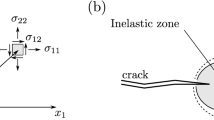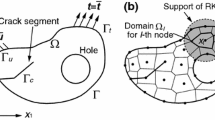Abstract
Through suitable selection of integration contours, M-integral is extended to the study of multi-defected fracture behavior in 2-D anisotropic elastic solids. In tact, by taking the integration with respect to the center of each defect, a problem-invariant parameter M c is defined. Special attention is thus addressed to discussion of the physical meaning of M c, which is shown to be related to the surface energy corresponding to formation of the defects. Based on this characteristic, it is suggested that M c be possibly used as a fracture parameter for description of the degradation of material and/or structural integrity caused by irreversible evolution of defects in the medium. In addition, a generalized domain integral method is developed for evaluation of the M c-integral with finite element method. The proposed numerical procedure appears to be domain-independent so that no near-tip singular behavior is involved in the calculations.
Similar content being viewed by others
References
Azhdari, A. and Nemat-Nasser, S. (1996). Energy-release rate and crack kinking in anisotropic brittle solids. J. Mech. Phys. Sol. 44, 929–951.
Budiansky, B. and Rice, J.R. (1973).Conservation laws and energy-release rates. ASME J. Appl. Mech. 40, 201–203.
Chang, J.H. and Pu, L.P. (1997). A finiteelement approach for J 2 calculation in anisotropic materials. Comp. Struc. 62, 635–647.
Chen, Y.H. (2001). M-integralanalysis for two-dimensional solids with strongly interacting microcracks. Part I: in an infinite brittle solid, Int. J. Sol. Struct., 38, 3193–3212.
Choi, N.Y. and Earmme, Y.Y. (1992). Evaluation of stressintensity factors in circular arc-shaped interfacial crack using L integral. Mech. Mat. 14, 141–153.
Eischen, J.W. and Herrmann, G. (1987). Energy release rates and related balance laws in linear elastic defect mechanics. ASME J. Appl. Mech. 54, 388–392.
Eshelby, J.D. (1974). Calculation of energy release rate. Posp.Frac. Mech. (edited by Sih, Van Elst, Broek), Noordhoff, Leiden, 69–84.
Freund, L.B. (1978). Stress-intensity FactorCalculations based on a conservation integral. Int. J. Sol. Struct. 14, 241–250.
Herrmann, A.G. and Herrmann, G. (1981).On energy release rates for a plane crack. ASME J. Appl. Mech. 48, 525–528.
Knowles, J.K. and Sternberg, E. (1972). Ona class of conservation laws in linearized and finite elastostatics. Arch. Rat. Mech. Anal. 44, 187–211.
Lemaitre, J. (1992). ACourse on Damage Mechanics. Springer-Verlag, Berlin.
Li, F.Z., Shih, C.F. and Needleman, A. (1985). A comparison of methods for calculating energy release rate. Eng. Frac. Mech. 21, 405–421.
Seed, G.M. (1997). The Boussinesq wedge and the J k, L,and M integrals. Fat. Frac. Eng. Mat. Struc. 20, 907–916.
Shih, C.F., Moran, B., and Nakamura, T. (1986). Energy releaserate along a three-dimensional crack front in a thermally stressed body. International Journal of Fracture 30, 79–102.
Wu, K.C.(1989). Representations of stress intensity factor by path-independent integrals. ASME J. Appl. Mech. 56, 780–785.
Author information
Authors and Affiliations
Rights and permissions
About this article
Cite this article
Chang, J., Chien, A. Evaluation of M-integral for anisotropic elastic media with multiple defects. International Journal of Fracture 114, 267–289 (2002). https://doi.org/10.1023/A:1015561313059
Issue Date:
DOI: https://doi.org/10.1023/A:1015561313059




